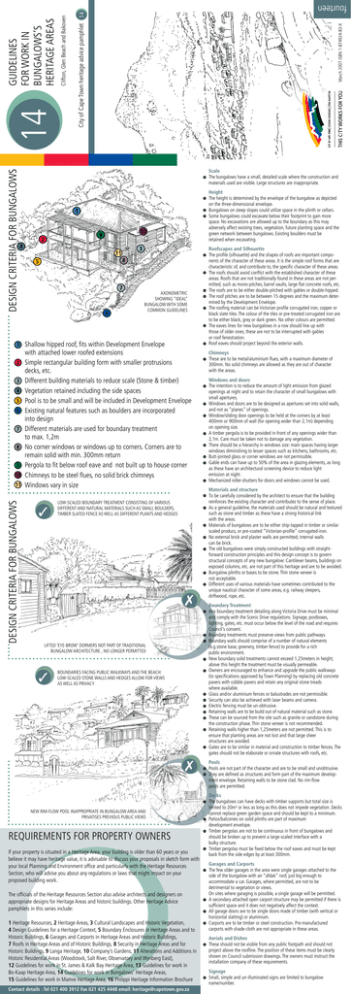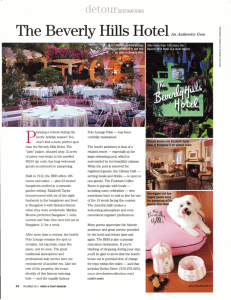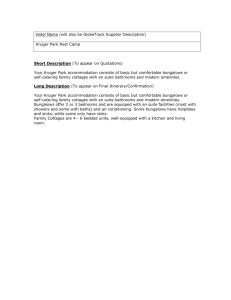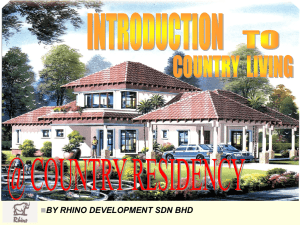Document 10392838
advertisement

march 2007 isbn 1-874924-83-X clifton, glen beach and bakoven city of cape town heritage advice pamphlet 14 14 guidelines for worK in bungalows’s heritage areas fourteen design criteria for bungalows Scale the bungalows have a small, detailed scale where the construction and materials used are visible. large structures are inappropriate. Height the height is determined by the envelope of the bungalow as depicted on the three-dimensional envelope. bungalows on steep slopes could utilize space in the plinth or cellars. some bungalows could excavate below their footprint to gain more space. no excavations are allowed up to the boundary as this may adversely affect existing trees, vegetation, future planting space and the green network between bungalows. existing boulders must be retained when excavating. aXonometric showing “ideal” bungalow with some common guidelines design criteria for bungalows shallow hipped roof, fits within development envelope with attached lower roofed extensions simple rectangular building form with smaller protrusions decks, etc. different building materials to reduce scale (stone & timber) vegetation retained including the side spaces pool is to be small and will be included in development envelope existing natural features such as boulders are incorporated into design different materials are used for boundary treatment to max. 1,2m no corner windows or windows up to corners. corners are to remain solid with min. 300mm return pergola to fit below roof eave and not built up to house corner chimneys to be steel flues, no solid brick chimneys windows vary in size 3 low-scaled boundary treatment consisting of various different and natural materials such as small boulders, timber slated fence as well as different plants and hedges 7 lifted ‘eye-brow’ dormers not part of traditional bungalow architecture , no longer permitted 3 boundaries facing public walKways and the beach: low-scaled stone walls and hedges allow for views as well as privacy 7 new rim-flow pool inappropriate in bungalow area and privatises previous public views reQuirements for property owners if your property is situated in a heritage area, your building is older than 60 years or you believe it may have heritage value, it is advisable to discuss your proposals in sketch form with your local planning and environment office and particularly with the heritage resources section, who will advise you about any regulations or laws that might impact on your proposed building work. the officials of the heritage resources section also advise architects and designers on appropriate designs for heritage areas and historic buildings. other heritage advice pamphlets in this series include: 1 heritage resources, 2 heritage areas, 3 cultural landscapes and historic vegetation, 4 design guidelines for a heritage context, 5 boundary enclosures in heritage areas and to historic buildings, 6 garages and carports in heritage areas and historic buildings, 7 roofs in heritage areas and of historic buildings, 8 security in heritage areas and for historic buildings, 9 langa heritage, 10 company’s gardens, 11 alterations and additions in historic residential areas (woodstock, salt river, observatory and wynberg east), 12 guidelines for work in st. James & Kalk bay heritage area, 13 guidelines for work in bo-Kaap heritage area, 14 guidelines for work in bungalows’ heritage areas, 15 guidelines for work in mamre heritage area, 16 philippi heritage information brochure Contact details : Tel 021 400 3912 Fax 021 425 4448 email: heritage@capetown.gov.za Roofscapes and Silhouette the profile (silhouette) and the shapes of roofs are important components of the character of these areas. it is the simple roof forms that are characteristic of, and contribute to, the specific character of these areas. the roofs should avoid conflict with the established character of these areas. roofs that are not traditionally found in these areas are not permitted, such as mono-pitches, barrel vaults, large flat concrete roofs, etc. the roofs are to be either double-pitched with gables or double-hipped. the roof pitches are to be between 15 degrees and the maximum determined by the development envelope. the roofing material can be victorian profile corrugated iron, copper or black slate tiles. the colour of the tiles or pre-treated corrugated iron are to be either black, grey or dark green. no other colours are permitted. the eaves lines for new bungalows in a row should line up with those of older ones; these are not to be interrupted with gables or roof fenestration. roof eaves should project beyond the exterior walls. Chimneys these are to be metal/aluminium flues, with a maximum diameter of 300mm. no solid chimneys are allowed as they are out of character with the areas. Windows and doors the intention is to reduce the amount of light emission from glazed openings at night and to retain the character of small bungalows with small apertures. windows and doors are to be designed as apertures set into solid walls, and not as “planes” of openings. window/sliding door openings to be held at the corners by at least 400mm or 900mm of wall (for opening wider than 2,1m) depending on opening size. a timber pergola is to be provided in-front of any openings wider than 2,1m. care must be taken not to damage any vegetation. there should be a hierarchy in windows size: main spaces having larger windows diminishing to lesser spaces such as kitchens, bathrooms, etc. butt-jointed glass or corner windows are not permissible. gable ends can have up to 50% of the area in glazing elements, as long as these have an architectural screening device to reduce light emission at night. mechanized roller-shutters for doors and windows cannot be used. Materials and structure to be carefully considered by the architect to ensure that the building reinforces the existing character and contributes to the sense of place. as a general guideline, the materials used should be natural and textured such as stone and timber as these have a strong historical link with the areas. materials of bungalows are to be either ship-lapped in timber or similar scaled producs, or pre-coated “victorian-profile” corrugated-iron. no external brick and plaster walls are permitted; internal walls can be brick. the old bungalows were simply constructed buildings with straightforward construction principles and this design concept is to govern structural concepts of any new bungalow: cantilever beams, buildings on exposed columns, etc. are not part of this heritage and are to be avoided. bungalow plinths or bases to be stone. thin stone veneer is not acceptable. different uses of various materials have sometimes contributed to the unique nautical character of some areas, e.g. railway sleepers, driftwood, rope, etc. Boundary Treatment any boundary treatment detailing along victoria drive must be minimal and comply with the scenic drive regulations. signage, postboxes, lighting, gates, etc. must occur below the level of the road and requires council’s consent. boundary treatments must preserve views from public pathways. boundary walls should comprise of a number of natural elements (e.g.stone base, greenery, timber fence) to provide for a rich public environment. new boundary solid treatments cannot exceed 1,25meters in height; above this height the treatment must be visually permeable. owners are encouraged to enhance and upgrade the public walkways (to specifications approved by town planning) by replacing old concrete pavers with cobble pavers and retain any original stone treads where available. glass and/or aluminium fences or balustrades are not permissible. security can also be achieved with laser beams and camera. electric fencing must be un-obtrusive. retaining walls are to be build out of natural material such as stone. these can be sourced from the site such as granite or sandstone during the construction phase. thin stone veneer is not recommended. retaining walls higher than 1,25meters are not permitted. this is to ensure that planting areas are not lost and that large sheer structures are avoided. gates are to be similar in material and construction to timber fences. the gates should not be elaborate or ornate structures with roofs, etc. Pools pools are not part of the character and are to be small and unobtrusive. they are defined as structures and form part of the maximum development envelope. retaining walls to be stone clad. no rim-flow pools are permitted. Decks the bungalows can have decks with timber supports but total size is limited to 20m² or less as long as this does not impede vegetation. decks cannot replace green garden space and should be kept to a minimum. patios/balconies on solid plinths are part of maximum development envelope. timber pergolas are not to be continuous in front of bungalows and should be broken up to prevent a large-scaled interface with a bulky structure. timber pergolas must be fixed below the roof eaves and must be kept back from the side edges by at least 300mm. Garages and Carports the few older garages in the area were single garages attached to the side of the bungalow with an “afdak” roof, just big enough to accommodate a car. garages, where permitted, are not to be detrimental to vegetation or views. on sites where garaging is possible, a single garage will be permitted. a secondary attached open carport structure may be permitted if there is sufficient space and it does not negatively affect the context. all garage doors are to be single doors made of timber (with vertical or horizontal slatting) or aluminium. carports are to be timber or steel construction. pre-manufactured carports with shade-cloth are not appropriate in these areas. Aerials and Dishes these should not be visible from any public footpath and should not project above the roofline. the position of these items must be clearly shown on council submission drawings. the owners must instruct the installation company of these requirements. Signage small, simple and un-illuminated signs are limited to bungalow name/number. introduction Historical background to the Bungalow Areas Cultural Landscape cape town has three “bungalow areas” along the atlantic coast. clifton, glen beach (at camps bay) and bakoven. these areas have over time developed a superbly appropriate response to the spectacular natural environment. they are significant cultural landscapes, as well as memorable places along one of the finest stretches of cape coastline: white sandy beaches, large granite boulders, steep and densely vegetated slopes, a family of similar sized wooden seaside bungalows hugging the contours overlooking the beaches and connected by narrow winding footpaths with interesting vistas and focal points, with the dramatic backdrop of lions head, table mountain and the twelve apostles. all these elements combine to create a unique landscape with a strong “sense of place” and which has been recognized as being conservation worthy. the natural and cultural landscapes at glen beach: bungalows nestling amongst thicK vegetation, facing the beach below the twelve apostles evidence suggests that the bungalow sites were in existence by 1903, when they were leased for camping purposes during the summer months. the first recorded building is a boatshed built by a e.b. denny in 1904 and the first bungalow was probably erected by a mr. d. bosman in 1909. during the housing shortage after the first world war, lessees were allowed to erect wooden bungalows as a temporary measure. the settlement was recognized as permanent in 1934 when council introduced the first waterborne sewage. the leases were changed over time, but mostly remained in place, until council resolved to sell the bungalow sites in the early 1990s. before the bungalows could be sold, the land had to be rezoned from public open space to single residential use Zone. this required resurveying all the bungalow sites. it was during this survey that the existing three-dimensional maximum development envelope of all bungalows were recorded and incorporated into the Zoning scheme, and the areas were demarcated with tpZ maps baKoven special area clifton scenic reserve protecting the cultural landscape provincial heritage areas the aim of these design criteria and guidelines is to raise awareness of the unique qualities that exist in this cultural landscape, how to conserve and enhance them, as well as to advise how the legislation protects these areas. scenic drive maps of three proclaimed bungalow heritage areas Applicable Legislation in addition to the national building regulations and building standards, (act no 103 of 1977), any development in the three defined bungalow areas, including the construction of any building or structure, and the removal of any vegetation, is subject to the following legislation: National Heritage Resources Act, No 25 of 1999 at local, provincial and national levels, the national heritage resources act (no. 25 of 1999) provides for the conservation and management of heritage resources and empowers society to assist in this management. with the introduction of this act, the bungalow areas are declared provincial heritage areas and any development needs authority from heritage western cape. The Land Use Planning Ordinance & City of Cape Town Zoning Scheme the lupo, along with the Zoning scheme, are designed to manage the physical development and use of land. lupo provides the legal framework for the application of the city’s Zoning scheme, in particular the following two sections of the scheme which deal with the bungalow areas: City Zoning Scheme, Section112: Bakoven, Clifton, Glen Beach all the bungalow sites are zoned ‘single dwelling residential use Zone’ in terms of the city’s Zoning scheme. section 112 of the scheme deals specifically with the bungalows areas as depicted on the plans tpZ 10557, tpZ 11167 and tpw 10556. each bungalow has a threedimensional maximum development envelope which represents the development rights of each bungalow owner and controls all development of the bungalow upward, sideways and downward. no point on any structure erected or to be erected on any site shall project or extend beyond the maximum development envelope. this includes ground-level decks and pools which are also defined as structures. this section also covers other criteria such as allowable materials, definitions, etc. City Zoning Scheme, Section93(1): Scenic Drive Regulations the clifton and glen beach bungalow areas and a small portion of the bakoven area lie below a designated scenic drive. these regulations controls all development abutting the lower side of any scenic drive, such as maintaining existing public views, to ensure that no structures or vegetation project more than 1,2m above the sidewalk of victoria road. 3 National Environmental Management Act, No. 107 of 1998; Section 23: Duty of care and remediation of environmental damage. the city might require a “construction phase environmental management plan” as well as the lodging of financial guarantees to ensure preservation of vegetation and other natural and physical elements. the act also regulates and restricts certain activities within 100meters of the sea and requires authorisation from the department of environmental affairs and development planning. the “green matriX” bungalows are separate buildings set within an eXtensively vegetated environment Clifton Scenic Reserve: the regulations governing this reserve need to be adhered to in any proposals. glen beach bungalow area falls within the clifton scenic reserve. Title Deed Restriction: each site has restrictions which must be adhered to. conserving & enhancing the natural environment 7 The Open Space – “Green Matrix” grid network of vegetation the natural landscape with its dense vegetation can be seen as a “green grid” between the bungalows. this is one of the most memorable attributes of the bungalow areas. these spaces are protected by the Zoning scheme and must be preserved. (the council might ask owners to enhance and complete this vegetation.) the coastal ecology is to be enhanced with indigenous coastal planting; different areas might have different plants due to slightly different climates. mature non-invasive alien trees and hedges (i.e. mannetoka) are protected. the green spaces between the bungalows are important landscape elements as well as view corridors onto, and from the beaches for residents and visitors and are to remain free of buildings, decks and hard surfacing. these green spaces ensure that the “built form” of these areas is one of free-standing buildings within a natural environment. high wall to public pathway removes previous public views over mountains and beaches the natural & cultural landscape 3 small-scaled bungalows with low hipped roofs surrounded by dense vegetation 7 inappropriate architecture not in character of bungalow areas 3 the shared views, vegetation and communal ground, enjoyed by residents as well as visitors to the beaches, must be protected. existing natural elements such as trees, hedges and boulders are to be protected and positively incorporated into any new work. spaces around the bungalows are to be planted with similar existing indigenous or naturalized coastal plants. new planting should not introduce conflicting themes or elements. the winding pathways are important landscape elements and need to retain their character, including view corridors between bungalows and vistas. relationship between bungalows and public pathways must be carefully considered, vegetation provides privacy Design Approach - Responding to the Built Environment the bungalows are a family of buildings and all respond similarly in the built form with architectural elements that are associated with the bungalow areas. each specific site is unique in its character as each site is different in its actual size, location, orientation and shape. as each bungalow has its own maximum three-dimensional development envelope, the planning considerations that apply to each bungalow will therefore vary considerably. interface between bungalows and public areas in many areas, buildings are at a `uniform’ setback between bungalow and boundary, be it (as in bakoven) between streets, or sea facing public open spaces. this is to be maintained and reinforced. orientation and siting of buildings new bungalows should respect the prominent orientation of bungalows facing onto the beach. this applies to all bungalows facing the various beaches. design criteria for bungalows an important consideration in assessing any bungalow re-development, is the character of the proposed design; i.e. the architectural considerations with regard to materials, fenestration, roof structure, boundary walls, fences, including any other structures, etc. and how these relate contextually to the established overall character of the surrounding area. 7 side spaces not te be eXcavated; sides to remain natural, with dense vegetation retained or planted Architectural Style each addition to a bungalow or new design should reflect the original character of the specific bungalow area. an over-arching design principle is that the identity of the area lies in the collective and not in the individual bungalow. the architectural form of a bungalow is generally a simple rectangle using a uniform set of elements and materials with a dominant double-hipped roof. this basic form can have various additions - closed or open (i.e. verandahs) - which are smaller than the main house-form. roofs of these additions should be simple lean-to’s and lower than the main roof. the bungalows traditionally had heavy plinths, often stone, on which the timber houses were built. this stone portion however must be less than one- third of the whole façade.







